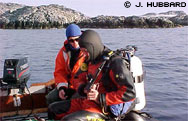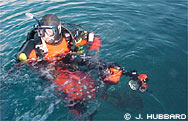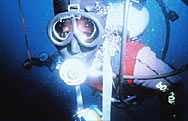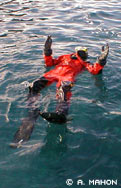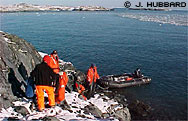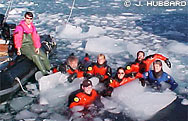April 13, 2000
Chuck Amsler
[Editor's note: In Dive Ops Part A Dr. Amsler described how the crew prepares for dives. In Part B he takes us through the dive and back to the station.]
To descend beneath the surface of the water we have to dump a lot of air from our dry suits. The dump valve is on the left arm, just below the shoulder. So we stick our left elbow up and out, kind of like we were trying to elbow a taller person in the side or make the handle in the children's "I'm a teapot" routine, and open the dump valve. We then set the valve so that it dumps air as needed throughout the dive. We descend feet first so that the dump valve is always up if needed. But during the descent we are primarily pushing on our inflator valve to add air as we go deeper. Most of us have the inflator valve located mid-chest, right over the sternum. We alternate adding air to the suit and pinching our nose and blowing against it to equalize the pressure in our ears as we descend. When we reach the bottom we add enough air to the suit to become neutrally buoyant at that depth. We check with our buddy or buddies to make sure they are OK (as we had been during the descent, too) and then proceed directly to whatever we have planned as our maximal depth. Sometimes we are already there but often we make our initial descent to a more shallow spot and then swim the rest of the way along the bottom. On the other hand, if we are diving on a wall, we may never actually be at what you'd call a "bottom" and so will drop off the boat close to the wall or over an adjacent ledge that lets us see the substrate so that we can orient ourselves during the descent. The maximum depth we can safely dive to is 130 feet. However, here at Palmer we have yet to exceed 120 feet and have only rarely gone much deeper than 110 feet. The majority of dives are shallower than that. Importantly, even when we go that deep we never stay that deep for more than a few minutes before rising up to shallower depths for the remainder of the dive. We are interested in collecting organisms from a variety of depths, so safety and science mesh together nicely. This kind of diving is what our dive computers are ideal for because they keep constant track of how long we have been at each specific depth in calculating how long we can stay in the water without being at serious risk of the bends. If we didn't have the computers we would have to assume that we had been at our deepest depths the whole dive and that would allow us much less total time in the water. As I have mentioned in previous journal entries, we almost always make safety stops of several minutes each at 20 and 10 feet depths on our way back up. These are not required decompression stops necessary to prevent the bends but we do them anyway just to add a safety margin. In a sense, we are pretending that we have been in deeper water for longer times. On many of our dives there is a great deal of surge, which is side-to-side water motion caused by waves. That gets stronger as we get shallower and if it is particularly bad, the 10-foot safety stop will usually be done a bit deeper or for a shorter period of time (or both) if we are coming up right along the shore as we usually do. It makes little sense to risk being bashed into the side of a boulder by heavy surge on a "safety" stop. Sometimes we swim out away from the rocks a bit for a relatively short 10-foot stop. When we break the surface we close our dry suit exhaust valves and add a bit of air to our suits. If we are live boating, we signal the boat that we are OK and they come over to pick us up. If not, we signal we are OK, put a few bursts of air into our BCs, and start the swim over to the boat. When the boat reaches us or we reach the boat, the tenders deploy ropes over the sides. Each hangs a foot of so below the surface and has a bowline loop in the end, some with large carabineer clips and some without. We clip our collecting bags into one of the carabineers so that they can hang there in the water while we get out. Coming off the bottom of our BCs are lines with brass clips at the ends. Sometimes we use these to hold our collecting bags when we are underwater. Now, though, we put one of the carabineer-less loops through that brass clip so that our BC, tank and regulators are tethered to the boat. We put air into the BC to help float the tank/BC/regulator assembly and then undo the waist band, one of the two shoulder straps, and unhook the inflator hose from our dry suit. That frees us from the tank. If a tender is available right then we help them get the tank assembly into the boat. But if not we can leave it floating there. Next we clip another of the carabineers through a metal ring on our weight belt harness, undo the waist band and one shoulder strap, and slip out of that, too. Now free of somewhere between 70 and 90 pounds of gear, we are like corks in our dry suits. We grab onto ropes hanging from the top of the rubber boat pontoons (1.5 to 2 feet above the water), bounce up and down a couple times to get some momentum, and then with our fins kick our way up and over the pontoons and into the boat.
By the time we've gotten back to the boat (often well before) we are cold and tired. The heavy duty dry suits we use are very bulky. They are fine if you don't need to go anywhere quickly, but swimming around in one is kind of like running uphill in an astronaut's space-walking suit (though undoubtedly cooler). Not that I've ever done that, mind you, but I imagine that while possible it wouldn't be particularly easy or efficient either. Added to the energy demands of swimming in water this cold your body is expending a great deal of energy just trying to stay warm. Between the cold sucking stamina from you like an energy leach, the rigors of swimming through the water while encased in a bulky rubber bag, and the processes of getting in and out of the boat, there isn't a lot left at the end of a dive or two. My non-academic recreation and the hobby that both my wife and I enjoy back in Birmingham is training for and competing in triathlons. Hilly 13-mile training runs or 70-mile bike rides that go up over both sides of Double Oak Mountain have nothing on the energy demands of a couple of Palmer Station dives. It is a different kind of tired, though. Not an aerobic depletion really. But, in a distinct but comparable way you are sucked close to -- but not quite -- energetically dry. There is no "endorphin high" like after a long aerobic workout but there is usually a "wow, this is a fantastic place" high to counterbalance the exhaustion. There is, unfortunately, one more little down side to diving here. By the end of the dive, your hands are very cold. Then after getting back on the boat, when your hands start warming up they sometimes, but not always, go through a few-minute period when they hurt in an almost indescribable way. OK, so a {open your thesaurus and add any six-to-ten synonyms you want for "tons of"} nasty pain is a start for describing it but whatever terms you chose from the thesaurus do not do it justice. I've had similar sensations in other situations where my cold hands were warming up but never as "thorough" or deep a feeling as it is after a dive. All one can do during that period is grimace and bear it. However, as I said, it only happens some days and after a few minutes the hands feel fine, as if the pain had never happened. It is a very strange few minutes, and it is not hard to tell when someone is going through it. There is a look one gets. On several pages of the WOW web site is a photograph of professional diver Jack Baldelli and me between dives here at Palmer in 1989. In looking at him in the photo, there is little doubt in my mind that Jack is grimacing and bearing right then. That is the look. The length of time we are at the dive site(s) varies depending on whether we put one or two buddy teams in the water and on whether we are doing one or two dives. Normally the minimum time on site would be a bit less than an hour. The maximum would be around two hours or a bit more but that is not common. When we have our gear off after the last dive we get it stowed back into some semblance of order around the bottom of the boat. It never seems quite as organized as it all had on the way out. We haul in the collecting bags, which have been hanging off in the water, and head back to the station. The Zodiac dock has a couple big flat rocks that are the best place to onload and offload gear. We nose the boat up onto the flat rocks and pass the gear ashore. The collecting bags go first and are taken immediately to the aquarium building where they are placed in running seawater. Everything else gets hauled up to the dive locker to be washed in freshwater. By the time everything is clean, the bulk of the morning or afternoon is gone, even if it was only one buddy team making one 30-minute dive. Lots of person-hours for a little bit of collecting time beneath the Antarctic sea.
After the last few paragraphs you must think us all mad, masochistic, or otherwise deranged for being here and doing this. Well, we may be "mad scientists" but if so, it is mad as in "mad about" what we are doing. And we are neither masochistic nor deranged. We just put up with a bit of discomfort from time to time as a small price for a big gain. On balance, the academic wonder, physical splendor, and biotic charm of our environs each, on their own, counterbalance the discomfort with a great deal to spare. We all know that we are lucky to be here and we are glad that we can share a bit of it with all of you via WOW. |

